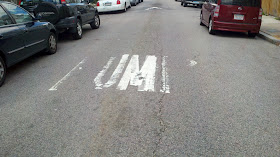 |
| Mozart Street, Jamaica Plain http://g.co/maps/y522d |
Mozart Street is a narrow, one-way local street in Jamaica Plain with parking on both sides. Vehicles driving along the street will encounter three speed humps. A speed hump is one method of traffic calming to maintain speed control along local streets. Speed humps have a gentler profile than a speed bump does and cars may drive over them comfortably going approximately 15 mph. Speed humps are usually around twelve to fourteen feet. However the speed hump itself is not the only important factor. The spacing of speed humps along the road is also important in the effectiveness of the speed reduction. They should be placed approximately every 250-300 feet to keep speeds lower and prevent injury and damage to the vehicle. The speed humps on Mozart Street, along with other traffic calming features of the street, are designed to achieve a road speed of about 20 mph. There is a desired low speed on this road due to the fact that it is a residential street that also has a grade school at the end of it with a playground across the street from it.
Speed Hump #1
When you turn on to Mozart Street from Lamartine Street you travel about 250 feet until you reach a stop sign when Mozart intersects Chestnut Ave. Right after you pass through this intersection, you are confronted with a sign alerting drivers of a speed bump ahead. However, this sign is incorrect because there is a speed "hump" ahead not a speed "bump".
 |
| Incorrect Sign trying to alert drivers |
 |
| Faded "HUMP" painted on the road approximately 20 feet from the speed hump. |
 | ||||
|
It is easy to observe from the picture above that from a distance without the signs on the side of the road a driver may not even know they are about to go over a speed hump. In addition, the speed hump they are about to drive over is not designed well enough to effectively reduce the cars speed. The cars are driving up a hill and do not slow down to 15 mph while driving over the speed hump. The grade of the speed hump is not steep enough, and drivers merely continue driving the same speed of approximately 20 mph. It is important to note that although the speed hump does not really force cars to slow down, due to its close proximity to the stop sign, cars are still going the desired street speed while going over the speed hump. Below is a link to a video showing cars driving over this speed hump: http://youtu.be/Ed6UDRAOR7M Speed Hump #2 : Placement The second speed hump along the road is approximately 350 feet away from the first speed hump which is more than the preferred distance between two speed humps. However, the characteristics of the street itself prevent cars from going very fast, anyways. After the first speed hump there is a sizable hill which keeps cars speeds low, plus there is a fairly sharp curve to the right about 100 feet after the first speed hump, which paired with the narrow street and parking on both sides, manages to keep vehicle speeds low. Speed Hump #2 : Design Once cars make it up the hill and around the turn they encounter a second speed hump. This speed hump could be said to be more important because it is right before a grade school pedestrian crossing. Sure enough, this speed hump is much more effective due to its larger height increase.
http://www.youtube.com/watch?v=AA6_4fInFmw&feature=youtu.be Speed Hump #3: The last speed hump has the same signs and postings as the other two. It is located approximately 150 feet away from the second speed hump which keeps the vehicle's speed nice and low. This speed hump (shown in the picture below) is not as dramatic as the second one, however the cars going over it are either still traveling slowly from the last speed hump, or turning onto the street, and therefore, also driving slowly. The speed hump is a raised pedestrian crossing, which you can tell by the zebra style painting, located about twenty feet before an intersection, so the speed hump was probably designed to keep the cars speed low while approaching the intersection and to help accomodate pedestrians. However, this speed hump does not have enough slope and therefore does not really force cars to slow down while going over it.
Conclusion The first two speeds humps need to have their markings repainted so that cars can see them better and take more caution. The first speed hump itself was not a good design because it was not large enough and cars could merely drive right over it at about 20 mph. There needs to be a longer sloped portion so that the speed hump may be higher which would force the cars down to 15 mph. The second speed hump was placed 350 feet from the first speed hump, however the natural design of the street helps to calm cars from picking up too much speed in between the two speed humps. The second speed hump itself was a good design with enough slope and height to slow cars to 15 mph. The third speed hump/raised crossing was a good distance of about 150 feet from the second hump, but like the first was too insubstantial and did not force cars down to 15 mph. Cars could easily drive over it at a speed of about 20 mph. In the end, though, the speed humps combined with the natural design of the road were effective to keep cars going about 20 mph throughout the street. |



No comments:
Post a Comment